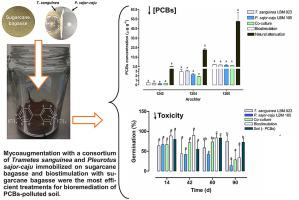Ecotoxicology and Environmental Safety ( IF 6.2 ) Pub Date : 2020-07-07 , DOI: 10.1016/j.ecoenv.2020.110929 Marcela Alejandra Sadañoski 1 , Ana Silvia Tatarin 1 , Mónica Lucrecia Barchuk 1 , Mariana Gonzalez 2 , César Nicolás Pegoraro 3 , María Isabel Fonseca 1 , Laura Noemí Levin 4 , Laura Lidia Villalba 1

|
The aim of this study was to investigate the bioremediation potential of polychlorinated biphenyls (PCBs) in soil, mimicking three strategies: (a) mycoaugmentation: by the addition of Trametes sanguinea and Pleurotus sajor-caju co-cultures immobilized on sugarcane bagasse; (b) biostimulation: by supplementation of sugarcane bagasse; and (c) natural attenuation: no amendments. The experiments were done in microcosms using Ultisol soil. Remediation effectiveness was assessed based on pollutants content, soil characteristics, and ecotoxicological tests. Biostimulation and mycoaugmentation demonstrated the highest PCBs-removal (approx. 90%) with a significant toxicity reduction at 90 d. The studied strains were able to survive during the incubation period in non-sterilized soil. Laccase, manganese-peroxidase and endoxylanase activities increased significantly in co-cultures after 60 d. Sugarcane bagasse demonstrated to be not only a suitable support for fungal immobilization but also an efficient substrate for fungal colonization of PCBs-contaminated soils. Mycoaugmentation and biostimulation with sugarcane bagasse improved oxidable organic matter and phosphorous contents as well as dehydrogenase activity in soil. Therefore, biostimulation with sugarcane bagasse and mycoaugmentation applying dual white-rot fungal cultures constitute two efficient bioremediation alternatives to restore PCBs-contaminated soils.
中文翻译:

评价土壤环境中难处理的卤代有机污染物的生物修复策略。
这项研究的目的是研究土壤中的多氯联苯(PCBs)的生物修复潜力,模仿三种策略:(a)真菌强化:通过添加Trametes sanguinea和Pleurotus sajor-caju固定在甘蔗渣上的共培养物;(b)生物刺激:通过补充甘蔗渣;(c)自然衰减:无修正。实验是使用Ultisol土壤在微观世界中完成的。根据污染物含量,土壤特性和生态毒理学测试评估修复效果。生物刺激和真菌强化表现出最高的PCB去除率(约90%),在90 d时毒性显着降低。所研究的菌株能够在非灭菌土壤中温育期间存活。在60 d后的共培养中,漆酶,锰过氧化物酶和内木聚糖酶的活性显着增加。事实证明,甘蔗渣不仅是固定真菌的合适载体,而且还是多氯联苯污染土壤真菌定殖的有效基质。甘蔗渣对真菌的强化和生物刺激作用改善了土壤中的可氧化有机物和磷含量以及脱氢酶活性。因此,用甘蔗渣进行生物刺激和采用双重白腐真菌培养物进行真菌强化可构成两种有效的生物修复替代品,以恢复被多氯联苯污染的土壤。











































 京公网安备 11010802027423号
京公网安备 11010802027423号